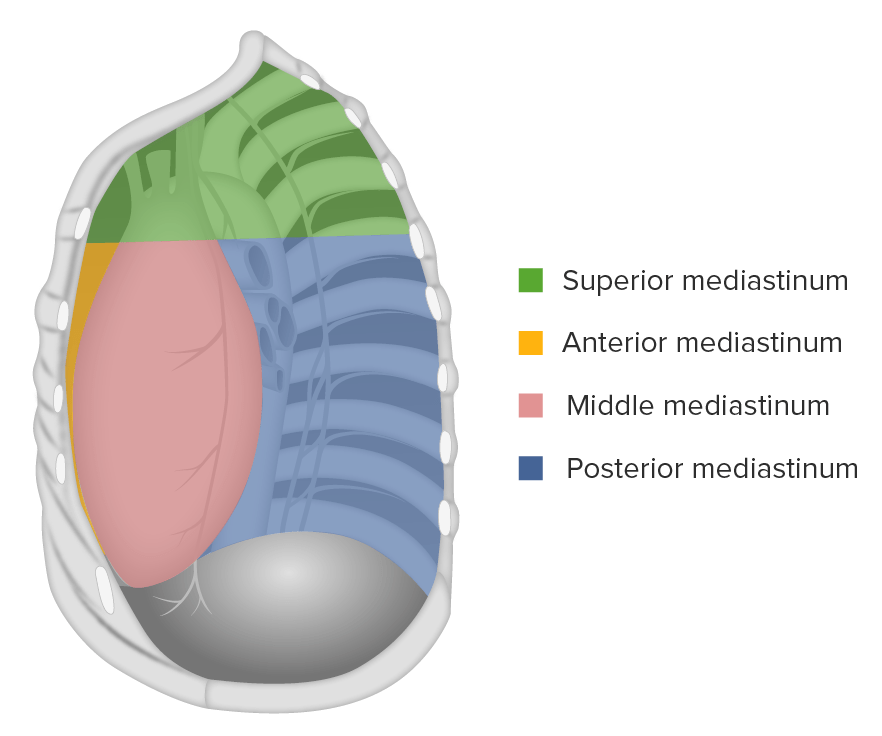Playlist
Show Playlist
Hide Playlist
Heart and Mediastinal Anatomy in Radiology (Part 2)
-
Slides Heart Anatomy.pdf
-
Download Lecture Overview
00:01 So before we begin our heart section, let's take a moment and review some normal heart anatomy on both radiograph and CT. 00:08 Let's start off with radiographic heart and mediastinal anatomy. 00:14 So where is the trachea? If you recall, this is the air-filled structure that's seen in the middle of the mediastinum and the spinous processes should be seen through it if the patient is facing forward without any rotation. 00:29 The superior vena cava forms a shadow along the right side of the mediastinum. 00:36 The right hilum, including the pulmonary artery is shown right here. 00:42 You can see areas of both lucency and density within the right hilum because it contains both vessels and bronchi. 00:50 The right atrium forms the right heart border. 00:54 The aorta can be seen as both the ascending and the descending portion. 01:01 The ascending portion is seen along the right side of the mediastinum while the descending portion or the aortic knob as it's called is seen along the upper part of the left side of the mediastinum. 01:11 The left hilum is seen symmetrically with the right hilum and you can see a portion of the descending aorta behind the heart. 01:21 The left ventricle is shown as the right heart border. 01:26 So how about the lateral projection? On the lateral view, you wanna make sure that you see a retrosternal clear space between the sternum and the heart. 01:37 The right ventricle is shown as the anterior heart border. 01:43 You can see the right hemidiaphragm and you can see the descending aorta which forms a shadow all the way from superior to inferior just behind the heart and in front of the spine. 01:56 You can see the hilum. 01:58 Both of the hila actually project over each other and you can see a combination of the hilum. 02:02 The left atrium forms the posterior heart border superiorly and the left ventricle forms the posterior heart border inferiorly. 02:13 And then lastly, we have the left hemidiaphragm which is seen as a slightly lower diaphragm with the right hemidiaphragm being the one that's higher up because of the liver located underneath it. 02:24 So let's look at some CT anatomy of the heart. 02:27 We can see the aorta and the pulmonary arteries very well on a contrast-enhanced study. 02:32 You can see here the ascending aorta and then posteriorly, you can see the descending aorta. 02:38 The pulmonary artery, you can see at its branch point right here with the right pulmonary artery and then the left main pulmonary artery. 02:47 This is an example of the heart anatomy seen on CT. 02:52 So the left ventricle is the one that has the thickest muscle. 02:56 Just next to it, along the entry or margin of the heart is the right ventricle. 03:02 You then have the right atrium which forms the right part of the heart and then the left atrium which forms the posterior aspect of the heart. 03:10 Right in the middle and coming from the left ventricle, is the aorta and then again posteriorly, you have the descending aorta. 03:19 As we take another slice through the heart, you can see the left ventricle at its largest portion and you can also see the right atrium in its largest portion. 03:31 The left atrium is seen posteriorly as an entrance to the left ventricle. 03:36 This is the coronal image from a contrast-enhanced CT scan and this just shows you another orientation of the heart. 03:45 So again, we can see the thick-walled left ventricle as it exits out of the aorta right here. 03:51 So this is the ascending aorta and we are turning up into the aortic arch right here. 03:57 You have the superior vena cava on the right and then you have the right atrium right here so the superior vena cava is entering the right atrium and then you have a very small portion of the pulmonary artery that you can see here. 04:10 So this was just the basic review of cardiac anatomy seen on both radiography and on CT. 04:18 Now, we'll delve into some more pathology that can be seen within the heart.
About the Lecture
The lecture Heart and Mediastinal Anatomy in Radiology (Part 2) by Hetal Verma, MD is from the course Thoracic Radiology.
Included Quiz Questions
Which structure forms the posterior heart border inferiorly on the lateral X-ray?
- Left ventricle
- Right atrium
- Right ventricle
- Right hemidiaphragm
- Descending aorta
Customer reviews
5,0 of 5 stars
| 5 Stars |
|
5 |
| 4 Stars |
|
0 |
| 3 Stars |
|
0 |
| 2 Stars |
|
0 |
| 1 Star |
|
0 |




